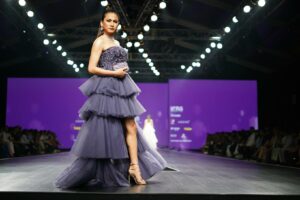Fashion design models play a pivotal role in bringing creativity and style to life on the runway. They are the canvas on which designers paint their visions, showcasing the latest trends and designs to the world. These models embody grace, confidence, and elegance as they strut down the catwalk, captivating audiences with each step. From haute couture to ready-to-wear collections, fashion design models are the living embodiment of the designer’s imagination, breathing life into every garment they wear.
 With their ability to embody different personas and styles, fashion design models serve as the bridge between fashion designers and the public, translating concepts into visual masterpieces. Their presence not only elevates the garments they showcase but also sets the tone for the entire fashion industry.
With their ability to embody different personas and styles, fashion design models serve as the bridge between fashion designers and the public, translating concepts into visual masterpieces. Their presence not only elevates the garments they showcase but also sets the tone for the entire fashion industry.
As trendsetters and influencers, fashion design models inspire individuals worldwide to embrace new styles and express themselves through clothing.
Fashion Design Model
At the start of the twentieth century, fashion design models began to emerge as trendsetters in the industry. Embodying grace and elegance, these models showcased designers’ visions on the runway, setting the tone for the evolving fashion landscape.
Early Twentieth Century
During the early twentieth century, fashion design models played a crucial role in bringing designers’ creations to life. With the rise of iconic figures such as Twiggy and Jean Shrimpton, models became more than just mannequins; they became muses for designers and inspiration for fashion enthusiasts worldwide.
Post-War Era to Modern Day
In the post-war era, fashion design models underwent a transformation, evolving from glamorous figures to influential personalities. With the advent of social media and the rise of influencers, modern-day models not only showcase garments but also shape trends and redefine beauty standards, making them integral to the dynamic fashion industry.
Key Elements of a Successful Fashion Design Model
The success of a fashion design model hinges on two crucial elements that set them apart in the industry.
Creativity and Innovation
 Fashion design models must embody creativity and innovation by bringing a fresh perspective to the runway. They are not merely clotheshorses but visionaries who can breathe life into the designer’s creations. By infusing their unique style and interpretation into each outfit, they ensure that the presentation is captivating and memorable.
Fashion design models must embody creativity and innovation by bringing a fresh perspective to the runway. They are not merely clotheshorses but visionaries who can breathe life into the designer’s creations. By infusing their unique style and interpretation into each outfit, they ensure that the presentation is captivating and memorable.
Through their creative expression, they elevate the garments to artistry, setting trends and pushing boundaries.
Business Acumen
Apart from their creative prowess, successful fashion design models possess exceptional business acumen. They understand the commercial aspect of the industry, recognizing the importance of brand partnerships, negotiations, and market trends. These models not only showcase the clothes but also endorse the brand effectively, leveraging their influence to drive sales and enhance brand visibility. Their ability to navigate the business side of fashion while maintaining their artistic integrity is a key factor in their sustained success.
Impact of Technology on Fashion Design
Technology has revolutionized the fashion industry, offering designers innovative digital design tools to enhance their creative processes. These tools streamline tasks such as pattern-making, prototyping, and digital rendering, allowing designers to bring their concepts to life more efficiently and accurately.
Digital Design Tools
Digital design tools like computer-aided design (CAD) software and 3D modeling programs have become essential for modern fashion designers. These tools enable designers to visualize their creations in a virtual space, experiment with colors, textures, and silhouettes, and make adjustments before producing physical samples. By leveraging digital tools, designers can iterate quickly, reduce production costs, and minimize waste in the design process.
E-Commerce and Online Showcases
 The rise of e-commerce platforms and online showcases has transformed how fashion design models interact with their audience. Models can now leverage social media, websites, and online marketplaces to showcase their portfolios, collaborate with brands, and engage directly with followers.
The rise of e-commerce platforms and online showcases has transformed how fashion design models interact with their audience. Models can now leverage social media, websites, and online marketplaces to showcase their portfolios, collaborate with brands, and engage directly with followers.
This direct-to-consumer approach allows models to build their personal brand, attract a global audience, and participate in shaping fashion trends in real-time. By embracing e-commerce platforms, models can diversify their revenue streams, reach a wider audience, and stay relevant in an increasingly digital fashion landscape.
Fashion design models play a crucial role in the ever-evolving fashion industry. From the iconic figures of the past to the digital transformations of today, models have adapted to new technologies and trends. Through perseverance and a commitment to their craft, fashion design models can shape the industry’s future while staying true to their unique visions.



